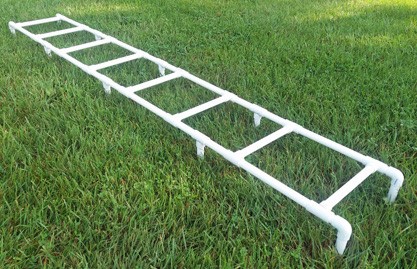Course Details
Taking the mystery out of cavalettis with more exercises than you thought imaginable. A great exercise for every dog whether you are looking to improve your ring presence in conformation, increase body awareness and strength for your agility dog or looking to introduce a new, fun activity.
This class will have Teaching Assistants available in the Facebook discussion group to help the bronze and silver students! Directions for joining can be found in the classroom after you register.
 Instructor: Leslie Eide, DVM
Instructor: Leslie Eide, DVMLeslie Eide (she/her) graduated from Colorado State University’s veterinary school in 2006. She completed a rotating internship in small animal medicine in Albuquerque, NM. She continued her education by becoming certified in canine rehabilitation through the Canine Rehab Institute...(Click here for full bio and to view Leslie's upcoming courses)
Syllabus
Week 1: Lecture: Set Up
Assignments:
Ladder
Trot Chute
Circular Trot Chute
Week 2: Lecture: History and Purpose
Assignments:
Crawling
Cavaletti Go Round
Week 3: Lecture: Dish Marker/Lure Marker/Easy Cue
Assignments:
Sit Jumps
Pick Up Sticks
Week 4: Lecture: Fatigue versus Pain versus Weakness
Assignments:
Over/Under
Figure 8’s
Week 5: Lecture: Planes of Movement
Assignments:
Side Steps
Walk Backwards
Week 6: Lecture: Creating a Workout
Assignments:
Burpees
Broad Jumps
Mountain Climbers
Prerequisites & Supplies
Set Up - Ideally, you have 6 to 8 rails that are adjustable. I prefer the ability to increase/decrease the height by 2”. There are many commercially available sets, but you can also make your own. You can be creative. The smaller the dog, the smaller the rail can be, but generally, I like to use a rail that is 1 inch in diameter. Examples of different setups will be included in the class.
Each week we will use a different set up of the cavalettis. It is important that there is plenty of space around the cavalettis for you to move and so that the dog does not feel pressure on their movement. When a straight line set up is required, this could mean you need as much as 35 feet to move back and forth. After measuring some of the spaces I have for cavaletti work, it may be possible to get away with a 20' by 20' area.
It is great if you have a Manner's Minder or some other robotic treat delivery system but not a requirement.
Sample Lecture
Exercise 1a - The Ladder
What defines the ladder exercise is that the rails are always set at the same height and the same distance, there is no variability. The typical ladder also does not change between dogs, whether tall or short, long or square. The down side to a typical ladder equipment (see picture) is that it really can only be used for limited exercises.
For this assignment we will use the Ladder set up only for walking straight forward.

Goal of the exercise - Body Awareness;
If you have the ability to change height of the rails, this exercise can also work on active range of motion in flexion.
Assignment:
1) Start by setting up the rails. This is a walking gait, so start with the rails spaced as far apart as your dog’s 3/4 height at the withers. Long backed dogs should start with the rails spaced equal to the dog's height at the withers (and we will make spacing adjustments as we go). A dog that is 24 inches tall at the withers would have the rails spaced 18 inches apart. A dog that is 8” tall at the withers would have the rails spaced 6 inches apart. The rails should be set to a height around the dog’s tarsus (ankle or hock). A small dog might need the rails set on the ground (but make sure they can’t roll around if they get knocked). In the video, the first dog is 21 inches tall and the rails are set 15 inches apart and 4 inches high. The second dog is 18 inches tall and the rails are set 13 inches apart and 4 inches high.
2) Next, place targets or a dish (or Manner’s Minder) on either end approximately 10 feet away from the first/last rail. If your dog is unfamiliar with using a target or dish for reinforcement take some time to teach that marker. This ability will come in handy as often we need the dog to look where they are going in this class, not at the handler.
3) I recommend starting with the dog on leash and walking through the rails with the dog (this will be next to impossible if you are using a traditional ladder). I recommend not luring or having reinforcement in your hand. The dog’s focus should be on the rails and/or straight ahead.
4) As you exit the last rail, give your marker for the reinforcement is coming on the target or dish (or activate the Robot Reinforcer). Let the dog get the reinforcement.
5) Walk around to the beginning and repeat.
6) You may need to stay walking with the dog in the rails for the entire first session (maximum 10 repetitions). If you feel comfortable you can move out side the rails while the dog continues to walk through them.
Trouble Shooting:
Problem: Your dog only looks at you and knocks over all the rails.
Answer: Get the reinforcer out of your hand, keep it in a treat pouch or somewhere else off your body, but easily accessible. Work on reinforcing on a target or in a dish or use a Manner’s Minder.
Problem: Your dog jumps over the rails.
Answer: Use a leash to maintain connection and walk slower. Try circling around, rather than walking back and forth, so that you can set an appropriate walking pace and maintain it. Walking back and forth incorporates stopping and starting, which are changes in speed, and can encourage more changes in speed as the dog moves through the rails.
Problem: Your dog does not want to stay in the rails.
Answer: Walk in the rails with your dog.
Decrease the number of rails you use initially. Try starting with 3 or 4 rails, then reinforce. After a few successful sessions of 3 or 4 rails, increase to 6, then increase to 8.
Problem: The lowest notch for my rail is 4 inches and my dog is only 10 inches tall.
Answer: Put the rail in the top notch and lay the cone over on its side or if using a true traffic cone, put the rail in the top and place the cone on its side. Now the rail is only about 1 inch high.
Advanced Exercise:
If your dog is comfortable walking through a traditional ladder, you can try trotting through the ladder. Remember that this will compress the natural stride of the trot especially the larger the dog. Balance this out by asking for extended trotting exercise (1b).
Testimonials & Reviews
A sampling of what prior students have said about this class ...
Cavalettis for Fitness was the most enjoyable class, my favorite so far but I say that after each FDSA class that I complete! The pace of the class was perfect, the week's lectures went up on the appointed day and nothing else was added. Leslie was an excellent instructor, worked tirelessly with each student providing helpful comments along the way. I would definitely take another class from Leslie. Thank you Leslie!
I was looking for a safe way to exercise my dogs, keeping them fit and mentally stimulated. This course was excellent. The course has finished but we are still working through the exercises at our own pace. Will use this information for a long time. Dogs loved it! Me too!
This class was fantastic! Life got a little crazy and I sadly didn’t get to keep up as well as I wanted to, but the exercises were interesting and fun, Leslie’s instructions were easy to understand, and her feedback kind and helpful. I’m excited to have lots of new awesome fitness exercises to use with my dogs! Jenn and Shout (and Ruckus)
Great class! I didn't realize so much could be done with cavaletti. I definitely would take another class with Dr. Eide. Thank you!
This is a wonderful class for any dog, regardless of conditioning level or experience. We’ve been religious about conditioning exercise for more than 4 years yet what we learned from Leslie has added a wonderful new dimension to our workouts. Leslie is very creative with how she uses cavalettis to achieve different goals and movement patterns, and she structured the class intelligently so that we progressed naturally through the exercises. Leslie’s lectures are very clear: I loved that each cavaletti had it’s own separate lecture, complete with exercise goal and troubleshooting tips. It’s a fun and exciting class for both humans and dogs — cannot recommend it enough. And crossing my fingers that Leslie does do a platform fitness class: I have a Klimb I’d love to get some new ideas for :). Thanks for such a great class, Leslie! Anna
This class added such another dimension to canine fitness and who knew you could do so much with a few cones and poles? Our dogs all got great workouts and the humans got a lot of education. I highly recommend this class for everyone in any kind of dog sports. Leslie was amazing and I hope she offers more classes!
This was an amazing class. The material was great, and Leslie did a wonderful job keeping up with forums and providing feedback in a timely manner. I hope to have the opportunity to take more classes with her in the future.
Registration
There are no scheduled sessions for this class at this time. We update our schedule frequently, so please subscribe to our mailing list for notifications.
Registration opens at 10:00am Pacific Time.
CC480 Subscriptions
 Gold |
 Silver |
 Bronze |
|
|---|---|---|---|
| Tuition | $ 260.00 | $ 130.00 | $ 65.00 |
| Enrollment Limits | 12 | 25 | Unlimited |
| Access all course lectures and materials | ✔ | ✔ | ✔ |
| Access to discussion and homework forums | ✔ | ✔ | ✔ |
| Read all posted questions and answers | ✔ | ✔ | ✔ |
| Watch all posted videos | ✔ | ✔ | ✔ |
| Post general questions to Discussion forum | ✔ | ✔ | ✖ |
| Submit written assignments | ✔ | ✖ | ✖ |
| Post dog specific questions | ✔ | With video only | ✖ |
| Post videos | ✔ | Up to 2 | ✖ |
| Receive instructor feedback on |
|
|
✖ |
Find more details, refund policies and answers to common questions in the Help center.